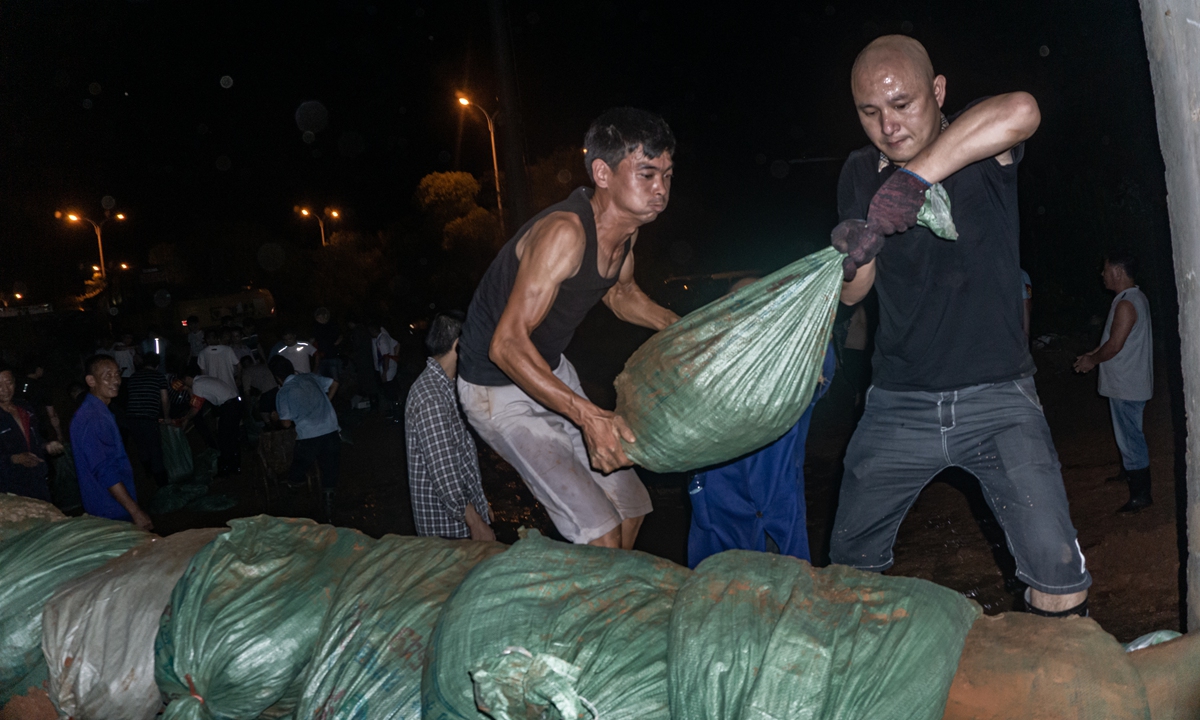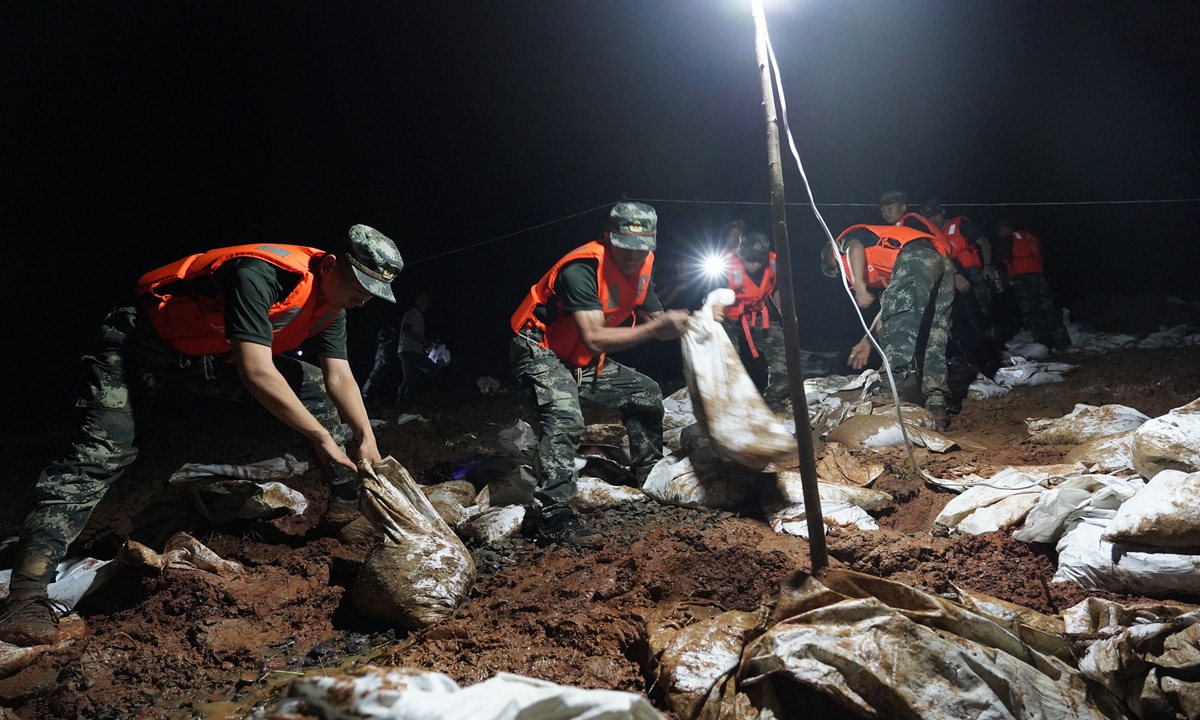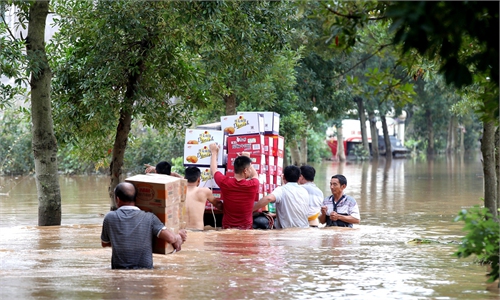
People put sand bags on dykes overnight to prepare for the rising floodwater in Poyang county, East China's Jiangxi Province on Sunday. Photo: Courtesy of Wang Zhonghua
In light of the alarming water levels exceeding that of 1998 in China's largest fresh water lake located alongside the Yangtze River, and with the upcoming rains expected to fall in the middle and lower reaches of the river, China raised its national flood response level on Sunday to its second highest, with the public keeping a close watch on whether the Three Gorges Project can withhold the floods and if the country will suffer the same fate it did 22 years ago.
Disaster-relief experts pointed out that economic growth has made the country more vulnerable to floods and prone to bigger losses, but the Three Gorges Project has made the river basin "much safer." Experts were also optimistic about the progress made in logistics, resources coordination and technology that can help the country overcome a major disaster with minimal impact.
At midnight Saturday, the water surface level at a hydrometric station at Poyang Lake in East China's Jiangxi Province, exceeded the 22.52 meter red mark of the 1998 floods. The 1998 disaster claimed some 4,150 lives and caused 160 billion yuan ($22.9 billion) in economic damages.
Jiangxi has entered "wartime mode" and raised its emergency response for flood control and disaster relief to the highest level.
Wang Zhonghua, a Poyang county official, told the Global Times on Sunday that village chiefs and Party members are stationed at the lake banks and enclosure dykes around the clock, and water gates have been consolidated to prevent breaching. Villagers are heightening the dykes with sand bags to prepare for a further increase in water levels, and reserve forces are ready, Wang said.
People living close to the water's edge have been evacuated and vital supplies are currently being prepared, he said.
Xia Shiwei, a township Party chief in Poyang county, said, "We check the weak points along the banks such as crevices and soil piping [and fix them]. Flood response resources are sufficient."
Xia estimated the water height would be above the warning level for a month as heavy rainfall within the region overlapped with neighboring provinces, making the discharge of floodwater slower than usual.
China's Flood Control and Drought Relief Headquarters on Sunday raised flood response levels to its second highest. It also allocated 190 rescue boats, 3,000 tents, 10,000 fold-out beds as well as 30,000 blankets to Jiangxi Province to support local flood response work. Equipment and materials have also been allocated to other provinces to aid their flood response work.
Jiangxi is not alone as the middle and lower reaches of the Yangtze, including Central China's Hubei and Hunan provinces, have also seen serious floods over the past few weeks. Wuhan, capital of Hubei, has seen its riverbank park below the dyke inundated by rising water.
The early rain season and extraordinarily heavy rainfall this year have already caused the deaths or missing of 141 people, the evacuation of 2.2 million people, and 82.2 billion yuan in economic losses.

Photo taken on June 29, 2020 shows water gushing out from sluiceways of the Three Gorge reservoir on the Yangtze River in central China's Hubei Province. Due to heavy rain in the upper streams of the Yangtze River, the Three Gorge reservoir has been seeing an increase of inflow recently. (Xinhua/Xiao Yijiu)
Test for Three Gorges Project
For the Yangtze River, the highest amount of rainfall and flood peaks usually occur in late July and early August, and the already alarming situation has prompted people to ask, will the floods of 1998 repeat again?
Analysts reassured the public that with the Three Gorges Project, which went into operation in 2003 and plays a critical role in mediating the water, a disaster on the scale of 1998 is unlikely to take place along the mainstream.
Zhang Boting, a senior analyst at the China Society for Hydropower Engineering, told the Global Times on Sunday that with the Three Gorges Project, the mainstream water level could remain low by holding the water in the upper reaches of the Three Gorges Reservoir, with Poyang Lake and other tributaries being able to discharge water into the Yangtze's mainstream.
The Yangtze's reaches are much safer than they were in 1998, Zhang said.
Amid the flood pressure in the middle and lower reaches, the Changjiang (Yangtze River) Water Resources Commission on Saturday reduced outflow from the Three Gorges Reservoir to 19,000 cubic meters per second. The amount will be adjusted in line with the upcoming rainfall.
The Three Gorges Reservoir reduced its water level in early June to 145 meters, 30 meters below its high water level to hold the upcoming floodwater.
Gao Jianguo, a member of the National Disaster Reduction Committee under the Ministry of Emergency Management, warned that despite the key role the Three Gorges Project could play in reducing mainstream flood control pressure, the lower reaches still face major challenges from regional rainfall that could bring about a smaller scale of floods and inundation.
Another concern is the typhoon season, which usually arrives in August and may potentially overlap with the Yangtze's flood season, threatening the lower reaches and the delta region.
In comparison to 1998, the high scale of development along the river means floods, water logging and inundation on the same scale will cause perhaps 10 times more economic losses. But technologies and innovative progress regarding the emergency response system also enhanced capabilities in handling floods and minimizing such impacts, analysts said.
Gao told the Global Times on Sunday that the country is now better prepared for floods, with more accurate monitoring and prediction of hydrologic and meteorological data. Progress in logistics and resources coordination also increased the capability of getting ready for a trans-regional emergency.
China now also has more professional machines to conduct bank consolidation, evacuation and reconstruction work after floods, Gao said.

Officers and soldiers from the Chinese People's Armed Police help strengthen a dyke at Mount Shahu in the city of Lushan, East China's Jiangxi Province, in the early morning of Sunday. China's Ministry of Water Resources on Sunday raised the emergency response for flood control to Level II, the second highest in its response system, as heavy downpours continued to lash vast stretches of the country. Photo: VCG
The Global Times learned from the frontline of the flood battle in Jiangxi that drones are now deployed to monitor floods and other geological occurrences in affected areas and broadcast live images to better conduct targeted rescue and relief work.
A resident from Nanlin village in Poyang told the Global Times on Sunday that in 1998, most people lived in bungalows which were easily inundated. But now most families have built two- to three-story houses and can wait for rescue if trapped by a sudden flood.
The development in communication infrastructure also saves time and costs in information sharing, giving more time for people to evacuate and get prepared, said the resident.
The extraordinary rainfall across the Yangtze basin this year is not only a test for the Three Gorges Project, but also a test for the country's disaster response mechanisms as a whole, analysts said.
The No.1 Yangtze flood peak formed on July 2 and the Three Gorges Reservoir withheld it smoothly. As the river usually has seven to eight numbered flood peaks (flood of a certain scale) each year between late July and early August, nature's biggest challenge has not arrived yet, Gao said.




